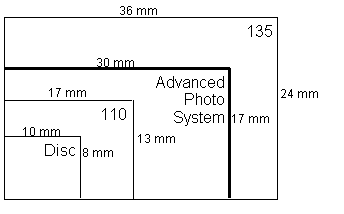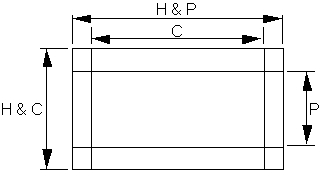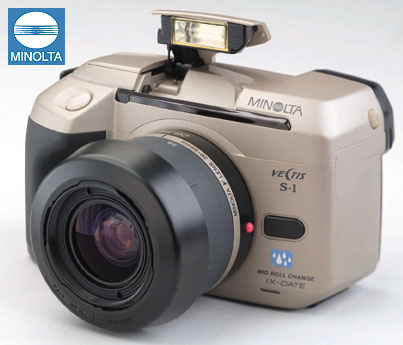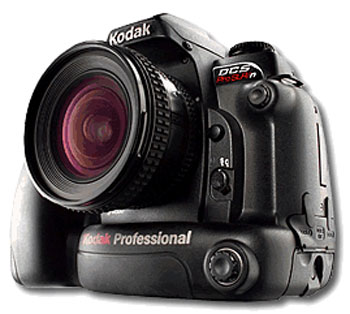The Digital Sensor: A Guide to Understanding Digital Cameras
by Wesley Fink on April 21, 2008 1:00 AM EST- Posted in
- Digital Camera
Why All these Different Sensor Sizes?
35mm first appeared on the scene in the 1930s and the film format simply took 35mm motion picture film and spooled it into a light-tight canister. By the 1960s, with point-and-shoot and developments in SLR technology, 35mm had become king of the film formats. Even as film manufacturers tried to introduce other film formats, 35mm continued to grow and prosper.
The SLR evolved in 35mm space and the world appeared orderly on the surface, but the only real constant was the size of the film. It was 35mm, but SLR manufacturers each championed their own lens mount and their exclusive lens line for their SLR film cameras. The primary advantage of the SLR was the ability to look through a wide variety of interchangeable lenses, and to accurately focus, meter, and later auto-focus through the viewing lens. As in today's digital SLR market, each manufacturer had their own lens mount, and lenses developed for one mount would not fit and work on others, i.e. a Nikon lens would not fit or work on a Canon camera.
APS (Advanced Photo System)
With the very early developments in digital photography, Kodak, Fuji, and others saw the handwriting on the wall for film photography. One of the ongoing complaints about 35mm film, however, has been that the 2:3 image format required image loss in almost every standard print size. Neither 8x10 nor 5x7 is a 2:3 ratio and both required cropping of the 35mm negative.

In 1996 a new APS (Advanced Photo System) initiative by Kodak, Fujifilm, Minolta, Nikon, Canon, and others was introduced to save film by standardizing on new ratios and adding new "computer-like" data storage capabilities in the taking and processing of film images. APS included a new film size - 30.2mm x 16.7mm - that could be printed full-frame (H or HDTV format), or use standard crops of 25.1mm x 16.7mm (C or Classic 2:3 format) or 9.5mm x 30.2mm (P or Panorama). Actually, the image size that was always shot was the 30.2mm x 16.7mm, and the other sizes were just standard crops.

The industry was confident they could sell APS, which in the most common C view was only about 55% of the already small 35mm size. Some manufacturers like Minolta developed new APS lens lines with smaller cameras and lenses, and Canon and Nikon developed APS camera bodies that could mount their regular lenses - and a few custom APS lenses.

In the end, APS failed in the film market. Industry pundits generally say APS failed because the negative was just too small, but it is more likely that it failed because it was just too late. Digital was on the near horizon, and many photographers did embrace smaller digital sensors while they rejected the smaller APS film format.
APS film is not that important in our discussion of digital photography, but the APS standard is important because it was also a standard for digital development. At the time of the APS initiatives, it seemed reasonable to aim for development of digital sensors for that same APS format, so lenses for both systems were interchangeable.
Most in the industry aimed for the APS C size sensor, which would be about 16.7mm x 25.1mm - the same ratio (2:3) as the classic 35mm format. Most manufacturers, burned by bad decisions in the APS film debacle, decided to keep their existing 35mm mounts, so their existing 35mm lenses could be used. They hedged their bets. This pleased current 35mm system owners, and camera makers could see if the new digital SLRs took hold. Once they were satisfied there was a market for digital SLR cameras, they could develop new lenses with a smaller image circle.

Canon and Nikon worked with Kodak in the early digital years to use their best film bodies with the current state-of-the-art Kodak sensors. These early DSLR cameras were incredibly expensive with massive power requirements and pro only. This development line culminated in the full-frame Kodak DCS Pro SLR/n and SLR/c. Those two cameras were the end of Kodak digital SLR cameras, although the company is still very active in the development and manufacture of digital imaging sensors and compact digital cameras.
Camera manufacturers introduced digital SLR products that revolved around the strength of their SLR business, the sensor capabilities they brought to manufacturing, and the relationships they had with other sensor manufacturers. Most of today's consumer DSLR cameras are based on sensors approximately APS C size, but they vary from the Olympus 4/3 sensor at 225mm² to the full-frame 35mm size with an area of 864mm².
Discussion of sensor size always tends to generate passionate discussion of the advantages of one manufacturer's sensor format over others, but please keep sensor sizes in perspective. The smallest 4/3 sensor still has 5.2x greater sensor area than the 43mm² sensor used in the 12MP Canon G9. The 4/3 sensor is 9x greater area than the common 1/2.5" compact sensor with an area of 25mm². Differences in digital SLR sensor size do matter, but they are very small compared to the difference in area between compact point and shoot digital sensors and today's digital SLR camera sensors.










72 Comments
View All Comments
Johnmcl7 - Monday, April 21, 2008 - link
On page 4:"The Foveon sensor falls between 4/4 and the Canon 1.6 in size and has a 1.7X lens multiplier."
I assume this should read '4/3'
Obvious question is what about Fuji? While I realise they re-use Nikon bodies and lenses, the discussion about Bater and Foveon makes no mention of Fuji's sensor. While it is more conventional than the Foveon, it's not just a bog standard bayer sensor and while Fuji are a minor player, so are Sigma.
For those who are not familiar with Fuji's design, they use two photodiodes at every point one larger and one smaller with the two combined to produce a single pixel in the output image. The idea is that these pair of pixels can capture more extended dynamic range than a standard bayer sensor of the same size. The latest version of this sensor is in the Fuji S5 Pro however it's limited to just 6MP although I can't remember if they still produce 12MP files from this. The S5 itself is basically a Fuji version of the very good Nikon D200 body although Nikon have of course moved on with the very impressive D300.
John
Wesley Fink - Monday, April 21, 2008 - link
Yes, it should have read 4/3 and the reference is corrected. The Fuji S3 was one of my favorite Nikon bodies and the dynamic range was certainly impressive in the studio.We did not mean to slight Fuji, but as one Nikon-mount body with a sensor that hasn't been updated in several years (the S3 and S5 sensors are the same as I understand it) we decided not to include the Fuji since there have been no sensor updates in quite a while.
Johnmcl7 - Monday, April 21, 2008 - link
"We did not mean to slight Fuji, but as one Nikon-mount body with a sensor that hasn't been updated in several years (the S3 and S5 sensors are the same as I understand it) we decided not to include the Fuji since there have been no sensor updates in quite a while. "I can't say I really agree there, given the article more focuses on concept in parts I think the S5 sensor is still relevent as it's something slightly different to the bayer sensor. The article refers to only Bayer and Foveon which implies there is nothing else, I think for completeness even if you don't go into any detail it's still worth mentioning Fuji are doing something else.
Also the S3 and S5 sensor are not the same, while they have the same amount of pixels it appears there's been some slight improvements although clearly not much. To be far to Fuji though, the Foveon sensor hasn't really come on much either - it's gone up very slightly in resolution with some small other changes but that's it pretty much. If the Foveon sensor had been just mentioned in passing I could definitely understand leaving Fuji with a similar mention but generally Fuji and Sigma are considered in the same boat as doing something a bit different although arguably with the Nikon body and mount Fuji have had more success.
John
melgross - Tuesday, April 22, 2008 - link
I never saw an advantage to their designs. I can't see what purpose having a smaller photo site on the sensor would do. It just has more noise, and less dynamic range than the larger sensor. I've read their papers on the subject, and they don't seem to have made a good case for it. Somehow, I think they understand that now.Johnmcl7 - Thursday, April 24, 2008 - link
"I never saw an advantage to their designs. I can't see what purpose having a smaller photo site on the sensor would do. It just has more noise, and less dynamic range than the larger sensor. I've read their papers on the subject, and they don't seem to have made a good case for it. Somehow, I think they understand that now."Are you referring to Fuji? If so, your information is incorrect - the last measurement I saw put the S5's sensor at slightly more dynamic range than the 35mm sensor in the Nikon D3. Their real problem at the moment seems to be resolution as well as having the older D200 based body.
John
strikeback03 - Tuesday, April 22, 2008 - link
I think Sigma (and Foveon) would be better off if Sigma could license a major player's mount, like Kodak did with the SLR/n and SLR/c. There are plenty of people who would like to have the sensor for the situations where it excels, but have no interest in a whole Sigma SA mount setup.pinto4402 - Monday, April 21, 2008 - link
I've been reading Anandtech for over 8 years now. I was a bit skeptical about your doing articles on digital cameras; however, this article put my reservations to rest. Very nicely done.I see why it makes sense for Anandtech to write about digital cameras. The nexus between computer tech and camera tech are very obvious if you've been following the trends. I'm a professional portrait photographer. In the last few years, it has become virtually impossible to remain in business unless you have a firm grasp on the latest camera tech as well as computer tech. I spend as much time on my computer as I do behind the camera. The camera has become a computer accessory (or vice versa). Many old timers who are hanging on to film are slowly being forced out. I'm somewhat of an old timer myself because I learned about photography when it was cool to have a darkroom, but I embraced digital equipment early.
Your graphs make it very easy to explain to people why their P&S (piece of s***) cameras are simply not adequate for serious portraiture. The MP count is marketing crap. As you demonstrated, it's the physical size of the sensor that matters.
Looking forward to part II of the series. Also, do you have any solid info on the introduction of 5D Mk II?
bjacobson - Tuesday, April 22, 2008 - link
"The MP count is marketing crap."Mostly. If you're willing to do some post processing yourself, the higher MP will enable you to decrease the IQ gap between the higher end DSLR and the ho-hum consumer camera. For this reason, since I wanted something compact and didn't really need a lot of optical zoom, I chose the Canon SD1100IS. 8MP, and while you begin to get noise at ISO400, more at ISO800, and tons at ISO1600, using a non-linear digital filter should correct most of that without blurring the image much (if at all).
strikeback03 - Wednesday, April 23, 2008 - link
Problem is that the camera has already blurred away lots of your detail at ISO 400 and up.http://www.dpreview.com/reviews/canonsd1100is/page...">http://www.dpreview.com/reviews/canonsd1100is/page...
Too bad there is no option to reduce/turn off the in-camera NR, for those of us who own a better program for it already.
Wesley Fink - Monday, April 21, 2008 - link
I wish I did have definitive info about the 5D Mark II launch, but the best info I have is this fall at Photokina. Rumors pop up every month that the new 5D will be here in a few weeks - and the last rumor was a definite April 22, which is tomorrow. Rumors are just that - rumors.